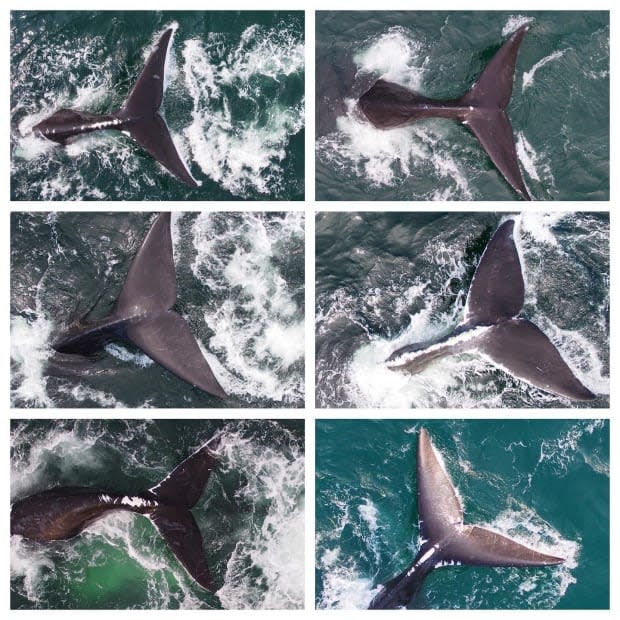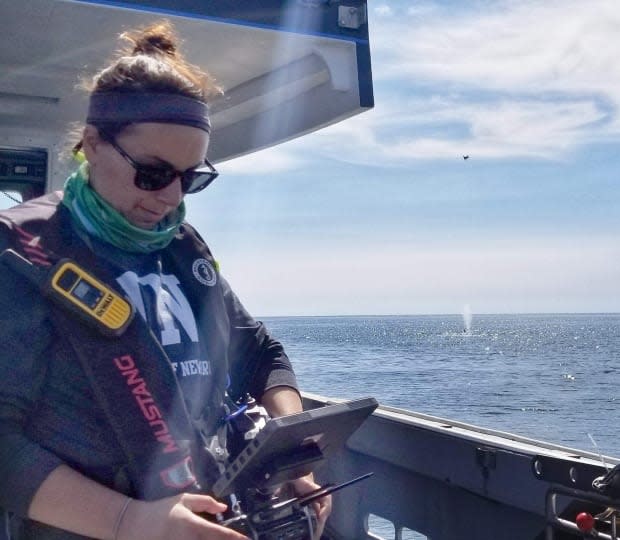N.B. whale researcher's stunning drone photos are turning heads

Gina Lonati's first brush with marine life came early. When she was five years old, her family took her to Sea World in California, where she came face to face with a dolphin — and knew immediately that she had just glimpsed her future.
"I still have the photo that my family took, of me looking at the dolphin for the first time and just being so captivated," Lonati said. "I was just thrilled, and knew I wanted to work with marine mammals as a career."
Years later, she is doing just that.
Lonati, now a PhD student at the University of New Brunswick in Saint John, studies the health of large whales in Atlantic Canada in a watery "classroom" perfectly suited to her research.
"The reason that University of New Brunswick kind of called me was [because] there are whales right in its backyard," Lonati said.
Lonati spends about three months of the year on the water, and the rest of it on land at the university.
It is deeply rewarding work, but it is also often troubling.
There are clear signs of dwindling numbers of right whales, which are dying faster than they can reproduce. With just over 330 remaining, these whales are regularly injured by ship strikes or suffer lethal injuries from fishing gear entanglements.
Climate change and changing currents are also affecting the location and quantity of their food sources.
"We went out in 2020 in the Bay of Fundy hoping to see some right whales and didn't see a single one," Lonati said.
Lonati hopes her research will yield information that can help turn the tide.
Government policies tend to focus on population numbers: how many whales died in a year, how many calves were born, how many entanglements were observed.

"But what I'm interested in is the health of the individual whale," Lonati said. "What's their body condition? Are they able to get pregnant? Are they finding enough food?"
Of course, to gather that information, you have to get an up-close-and-personal look at a whale in its natural habitat — without getting close enough to cause the very stress you're trying to prevent.
To do this, Lonati relies heavily on one piece of research equipment in particular: a drone.
"If you know the altitude and the focal length of the camera, you can actually measure how long the whale is and how wide it is and get an estimate of its body condition … without getting close enough to disturb it," she said.
Surprise photograph wins national prize
Over the years, Lonati has amassed a library of striking and sometimes haunting images of right whales, humpback whales and other marine mammals.
Many have been enlarged and mounted as artwork on Lonati's walls.

"There's a very obvious theme of decor in my apartment," she said with a laugh.
Others have caught the eye of a wider audience.
Her photo of a humpback whale exhaling out of its blowhole was recently one of four winners in the National Sciences and Engineering Council of Canada's Science Exposed photo contest, which is devoted exclusively to images of scientific research.
Lonati said she was surprised by the image when she was reviewing her footage at the end of a field project.
WATCH | Catching a whale's 'rainbow' moment:
In that photo, Lonati's drone was directly over a humpback whale at the exact moment it exhaled, spraying water into the air.
"The water droplets reflect the sunlight in a manner that it produced a rainbow," Lonati said.
The photo captured a moment when art met science, she said.
"I thought that was just especially remarkable."
The university's lab has permits to approach the whales and fly the drone, and she has advanced certification to fly drones in Canada.
"This isn't something that just anyone can pick up a drone and go," particularly considering the trauma many whales are already subjected to, she said.

Lonati's images capture these more distressing realities, too.
A combo photo of six right whale tails appears postcard-pretty at first glance, capturing what Lonati calls their "quiet, majestic beauty" as they slip into the water.
But a closer look reveals something less enchanting.
"You can see all these white scars from these animals having been entangled [in fishing gear]," Lonati said. "I think it's now 86 per cent of right whales have been entangled at least once, and some have been entangled six or more times."
Lonati, who is in the second year of her PhD program, hopes that in the years ahead, her drone-assisted research can help improve the odds for right whales specifically, and the health of whale populations in general.
"I would love to be a professor someday and mentor students and have my own lab, so I can continue asking these questions and conducting research," she said.
In the short term? Her goal is a little more family-focused.
"My parents recently told me they've never been whale-watching," Lonati said. "When I heard that, I was like, 'How did this happen?' So my goal is to do something about that."


 Yahoo Movies
Yahoo Movies 
